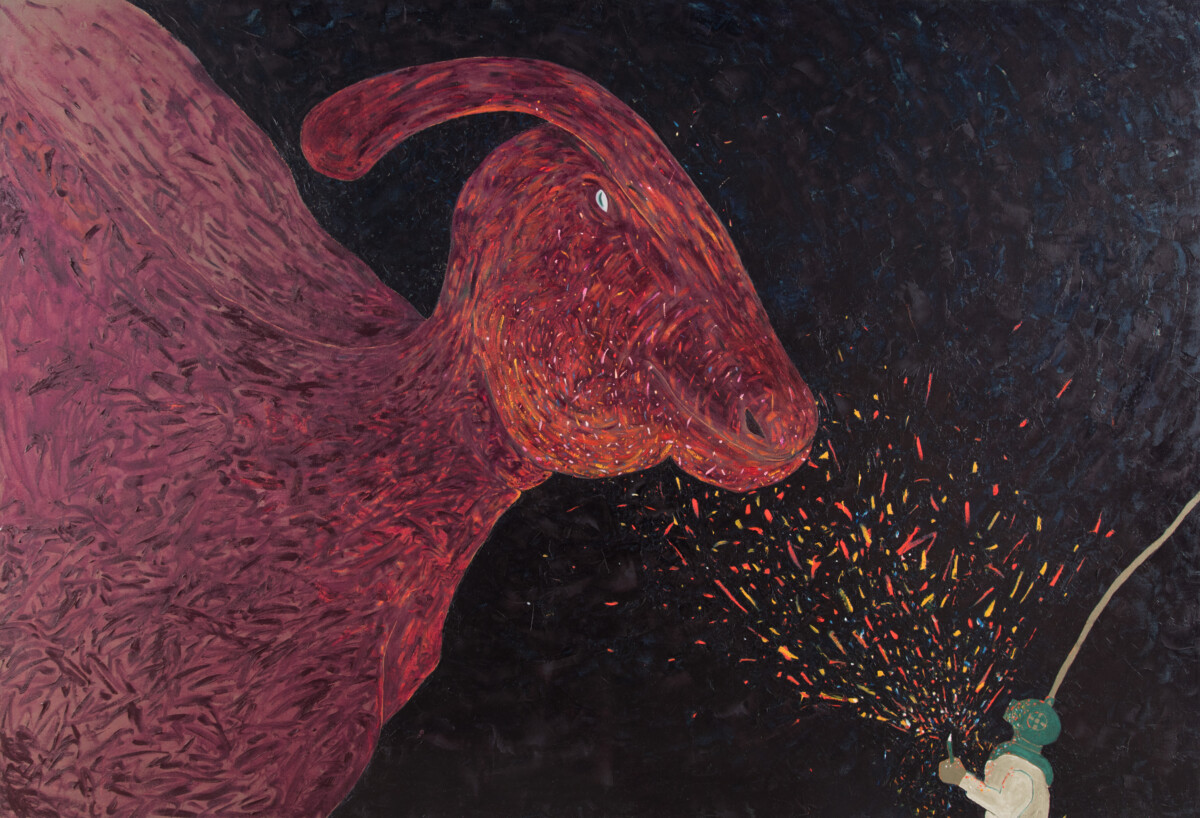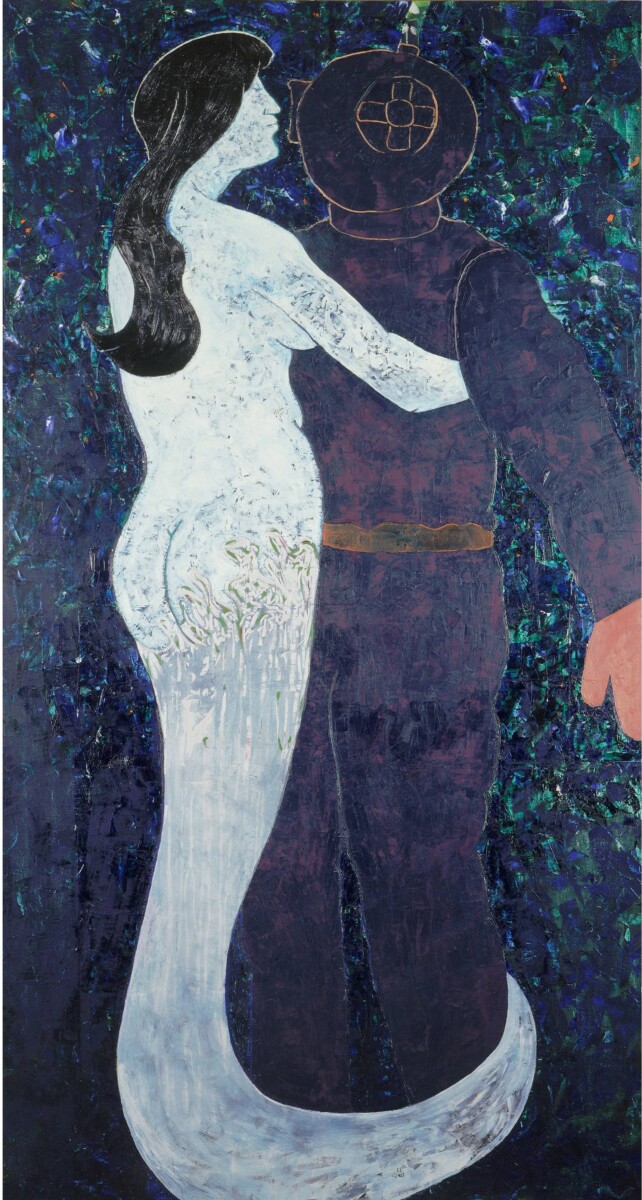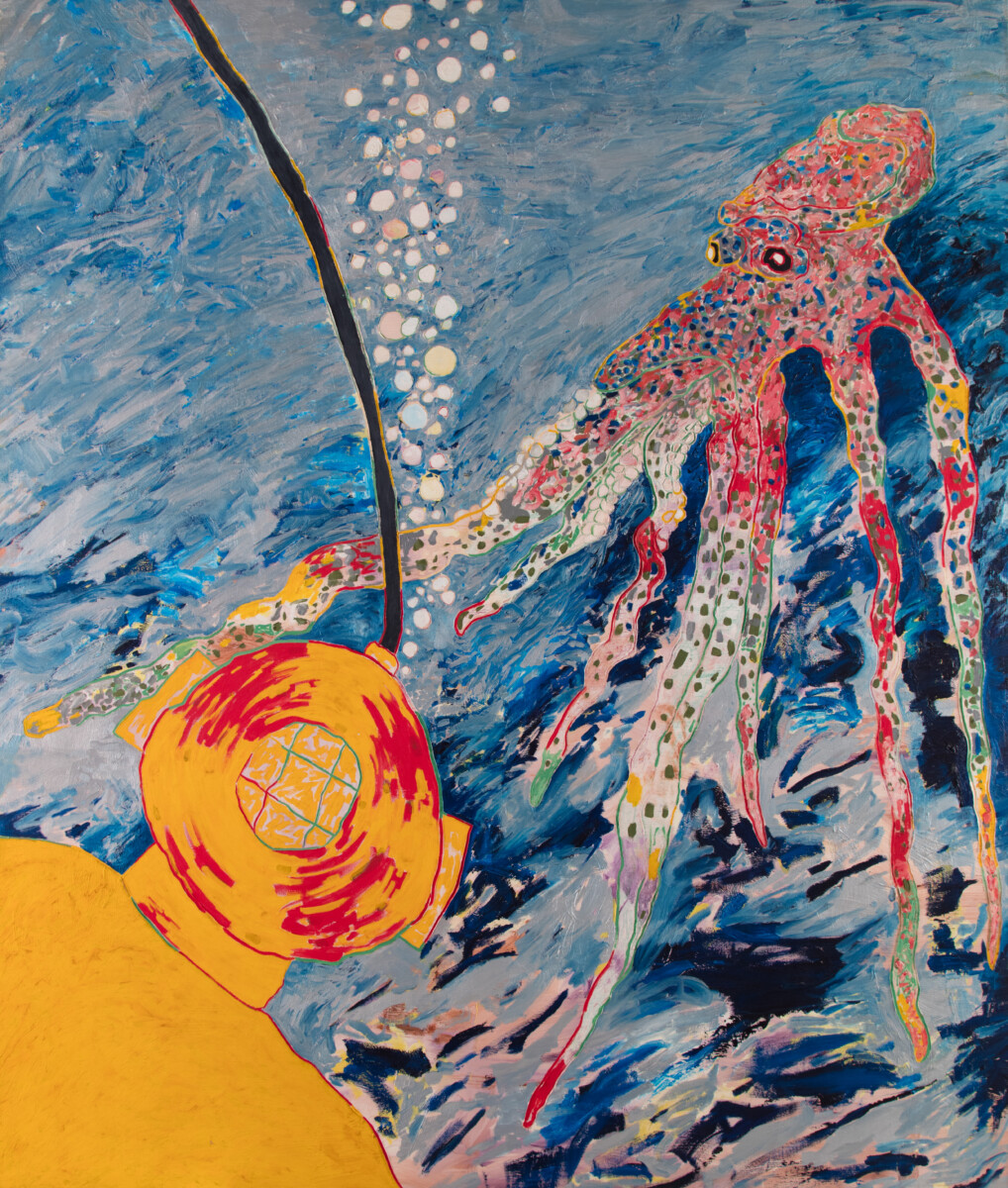Flicker of Recognition, 1984
Exhibitions: William S. Dutterer

Bill is to Joe as Joe is to Bill. “William S. Dutterer: Joe Diver” invites viewers to immerse themselves in a world where art and introspection intertwine. Completed in the mid 1980s, this series of five paintings tells the story of Joe Diver’s adventures beneath the waves, mirroring the artist’s own journey of discovery of the self and his artwork. Joe Diver comes to us as a representation of the artist himself, searching and exploring the depths of art, life, and what it means to create. Continually taking stock of his own thoughts, Dutterer documented his feelings and perception of the present works. In July 1981, he writes “ ‘Here’s Looking at You’ / Diver’s helmet as eye/ Air line—-umbilical cord/ The water—isn’t that where we came from? … ‘looking’ is hard enough whether it is inward or outward & that ‘Seeing’ is almost impossible./ Another of the diver paintings is titled ‘Deep See’.” As viewers follow Joe Diver on his underwater odyssey, we’re invited to “see deeper.” Just as the ocean is vast and full of mystery, so too are the inner workings of the human mind and pathos. By portraying Joe Diver, Dutterer’s alter ego, as a fearless explorer in his antique diving suit, the artist challenges viewers to confront their fears and dive deep into the unknown aspects of their own selves, inviting viewers to consider the ways in which they too might use art as a tool for self-exploration and expression.
About the artist:
William Sherman Dutterer was born in 1943 in Hagerstown, Maryland, a blue-collar, railroad town between the borders of West Virginia and Pennsylvania. His childhood and teenage years claimed experiences that would later deeply inform his thinking, subject matter, and knack for experimentation including: the beginnings of rock music, tattoos, quilting and craft, race cars, and those ever-powerful trains passing through town. In an effort to avoid the Marines, Dutterer enrolled at Maryland Institute College of Art (MICA) in Baltimore, MD, receiving his BFA in 1965 and MFA from the school in 1967. During those seminal years, he studied under and assisted the lauded Second Generation Abstract Expressionist Grace Hartigan who would continue to be a great friend and colleague throughout his life.
Upon graduating, Dutterer moved to Washington, D.C. and taught painting at The Corcoran School of Art while continuing his art practice alongside artists of the second generation of Washington Color Field painters, including Sam Gilliam, Thomas Downing, and Howard Mehring. In 1979, Dutterer and his wife Jamie Johnson relocated to New York City, setting up a studio and living space in Soho while he continuing to commute weekly to and teach at the Corcoran. In 1986, he took a new teaching role at The New School in New York, leaving his longtime post at the Corcoran School. For the next two decades, he encountered personal injuries, embraced travel and explored alternate art and crafts, specifically tribal masks, textile and Afghan rugs, all of which seeped into his artmaking. William Dutterer passed away in 2007, leaving behind an ever deepening and unfinished body of work. An artist’s artist, he believed in separating himself from the greater art world and avoiding interaction with galleries and dealers. Today his oeuvre bears a timelessness and follows a story of exploration and art for art’s sake.
Dutterer’s practice was progressive and varied. His attention and care to art making began in graduate school at MICA’s Hoffberger School of Painting and continued until his death, leaving works in progress stacked against the wall and propped on his easel. His earliest works were deeply informed by the color field, minimalist canvases of his contemporaries in Washington D.C. in late 1960s-1970s. Exploring the potential of light and time in relation to pigment, works from this period take on deep and transportive fields, becoming interactive spaces for viewers. While Dutterer received significant acclaim and accolades for this body of work, the series left him feeling restricted, as if he had solved for and accomplished the aesthetic and formal experiments this type of minimal practice could only allow for. He wanted to pull back the layers of purpose, artmaking, and experience, which ultimately led him to leave the series and begin anew.
Over the next four decades, his artmaking and theoretical drive expanded with regard to conceptual and material experimentation. The 1970s ushered in a series of Cut and Folded paintings, where the artist began puncturing and peeling back the physical surface and canvas. The Word-Image series of 1976 marked a year of wordplay and idolic imagery paintings on paper and more importantly, the beginnings of a return to figuration from a purely abstract style; 1977 through 1979 saw an elimination of the words, focusing purely on figurative motifs, titled his Icon series. In the 1980s, Dutterer’s exploration took on a literal and figural form with the introduction of Joe Diver, a deep-sea explorer and stand-in for the artist himself, once again searching for purpose and meaning in his art making. The late 1980s-1990s brought two new motifs – the alligator and train – the former hovering between the sea depths and sky and the later plowing through the landscape, lights ablaze. In the mid 1990s and up until his death, his work progressed and visually simplified to floating heads. As world events collided with his personal life, particularly his relationship with Afghanistan and the US war, the heads became increasingly poignant and isolated, eventually masked, gagged, bound, and/or voiceless, hovering in a void of increasing distress. Dutterer passed away with his final series of heads, Soto Voce, still in production and considered by many of his colleagues as his finest work.
William S. Dutterer has exhibited globally, in both solo and group exhibitions, including the 34th Biennial (1975) at the Corcoran Gallery of Art, Washington D.C. (1968, 1969, 1970), Prospect ’73 Painters, Kunsthalle Düsseldorf (1973), and the Baltimore Museum of Art (1970), Detroit Institute of Art (1969), Instituto Guatemalteco Americano (1972), Miami Arts Center (1975), and Mana Contemporary, Jersey City (2022), among many others. His work is in the Carnegie Museum of Art, Pittsburg, PA; Corcoran Gallery of Art, Washington D.C.; The Katzen Arts Center, American University, Washington D.C.; and the National Gallery of Art, Washington D.C., including other private and institutional collections. Dutterer taught painting at The New School (1986-1987) and at The Corcoran Gallery School of Art (1967-1986) and was the recipient of various awards and grants, including the Visual Arts Fellowship, National Endowment for the Arts (1980), Ford Foundation Grant (1979), and the Workshop Fellowship, Washington Gallery of Modern Art (1968).



